 |
| A pearl along the
Jinsha River. |
 |
| Panzhihua was a
barren land 35 years ago. |
THE city of Panzhihua (kapok flower) was China's first
special resource-development zone. Panzhihua is also known as
Steel City. The Ertan Hydropower Station there is the largest
hydropower station built in China in the 20th
century.
Panzhihua is in southwest China, at the junction
of the Jinsha and Yalong rivers. As China continues its push
to develop the western regions of the country, China Pictorial
has selected Panzhihua as the first city to be covered in a
series of reports on west China.
The First Phase of
Development
No map of China older than 35 years will show
Panzhihua. The area began to develop only forty years ago,
when a vein of precious minerals was found in a large valley
between Sichuan and Yunnan Provinces, nestled among the hills
between the Qinghai-Tibet and Yunnan-Guizhou plateaus. The
vein had a great density with a potential value of US$6,000
billion according to the exchange rate in the 1990s. The
minerals included vanadium-titanium magnetite. The area had no
name at that time, and there were only seven households and a
tall kapok tree, known as "panzhihua'' in Chinese. "Let's call
the place Panzhihua,'' said Chairman Mao Zedong with a
smile.
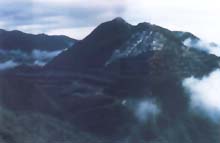 |
Panzhihua has
abundant vanadium-titanium magnetite.
by Hong
Jie |
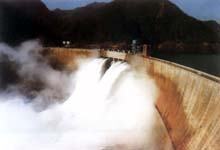 |
| The Ertan
Hydropower Station. by Song
Zhiping |
In the spring of 1965, the first generation of Chinese
leaders decided to push the modern productive forces from the
eastern coastal areas to China's west to transform the
industrial structure there. Ten thousand construction workers
were dispatched from every corner of the country to the barren
land of Panzhihua. Without any railroads or urban facilities,
these workers used their hands and shoulders and relied on
highways to build the Panzhihua Iron and Steel Complex (the
present Panzhihua Iron and Steel Company) on a
2.5-square-kilometer slope known as Nongnongping. The
enterprise produced 2.5 million tons of steel a year and was
regarded by experts as a wonder in world metallurgy because of
its unique smelting technique.
The 1,100-kilometer
Chengdu-Kunming Railroad, which passes through the
geographically complicated canyon in Panzhihua is considered
one of the three wonders of humanity's conquest of nature in
the 20th century, and a miniature ivory carving of a section
of the railroad stands at the headquarters of the United
Nations.
The Second Phase of Development
In the
mid-1980s, in the tide of China's reform and opening-up, the
people of Panzhihua launched their second stage of
development. As a state-owned enterprise, the Panzhihua Iron
and Steel Company borrowed US$210 million from the World Bank
for its own second phase of development and built a production
line for steel sheets, heavy rails, and vanadium products.
Because of Panzhihua Iron and Steel, China has changed from a
vanadium importer to an exporter.
Then, to utilize the
water resource at the Yalong River, the largest tributary of
the upper reaches of the Yangtze River, US$930 million was
borrowed to construct a 240-meter-high multiple-dome Dam and
the Ertan Hydropower Station. The Ertan Hydropower Station
ranks third in the world among hydropower stations because of
its installed capacity of 3.3 million kilowatts and its
average power generating capacity of 17 billion kwh a
year.
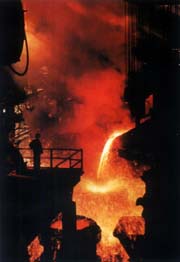 |
 |
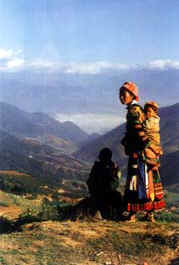 |
| Extracting
vanadium. by Hong Jie |
World-famous Panzhihua iron |
The ethnic
minorities in west China contribute greatly to the local
economy
by Qu
Yingxiang |
Along with the industrial development, Panzhihua's
agriculture has also seen rapid growth. The area is in the
subtropical zone and is not attacked by typhoons. The
plentiful sunshine and rain give Panzhihua a reputation as a
natural greenhouse, and Panzhihua was China's first
agricultural pilot area. The area has been designated as a
subtropical fruit production base and has become a center for
growing vegetables to be sent to the north.
Panzhihua has
now developed into a medium-sized mountain city with
subtropical landscapes along the Jinsha River and has become
the center of transport, commerce, and finance for
southwestern Sichuan and northwestern Yunnan provinces because
of its modern technology, including digital transmission,
computer-controlled telephone exchanges, satellite
communications, and wireless mobile communications.
A
marked gap still exists between Panzhihua and China's eastern
cities, but with the push for developing the western regions
of China, the people of Panzhihua have seized the opportunity
and worked out development plans.
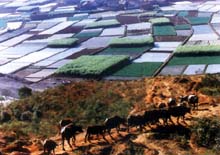 |
| Rural scenery in
Panzhihua. by Xiao Zejin |
Panzhihua will speed up the construction of its airport and
will make the Chengdu-Kunming Expressway a major project of
Sichuan and of the country as a whole. Panzhihua will
readjust, optimize, and upgrade its industrial structure to
become a worldwide vanadium-magnetite producer. Furthermore,
the city will stimulate the chemical industry by making use of
the Ertan Hydropower Station.
Along with its industrial
growth, Panzhihua will establish a high-yield, high-efficiency
agriculture and will expand its tertiary industries including
tourism, e-business, and information service. Panzhihua has
2,400 square kilometers of natural forests, but owing to the
unique climate, the afforestation season in the area runs only
from June through August. The people of Panzhihua will turn
260 square kilometers of cultivated land into forests in the
near future and will make a green forest from what is now
wasteland.
Panzhihua, a city developing on a barren land,
is a model for China's development. Facing the great tide of
development in west China, it will embark on another march
with a pioneering and progressive spirit.
|